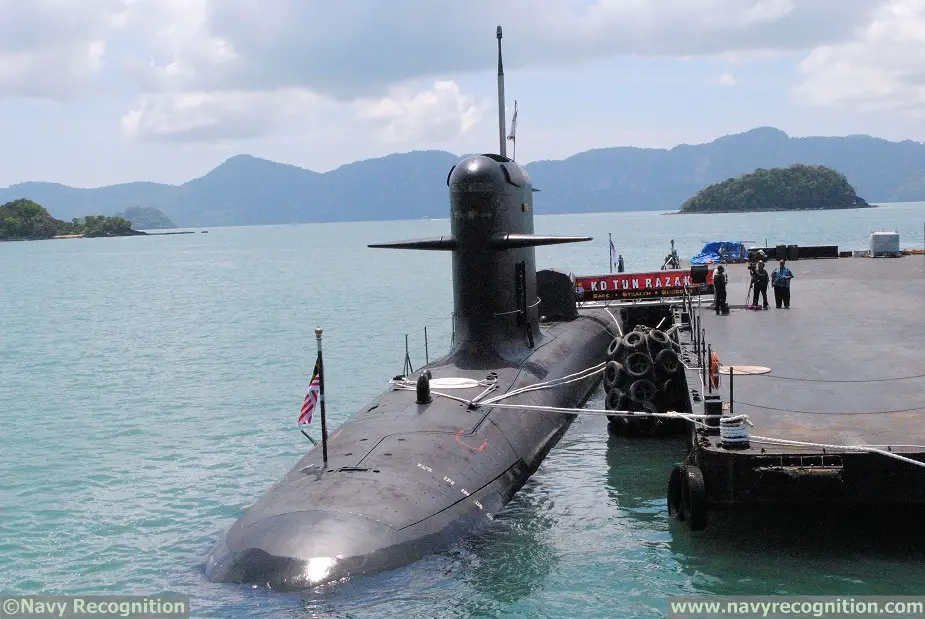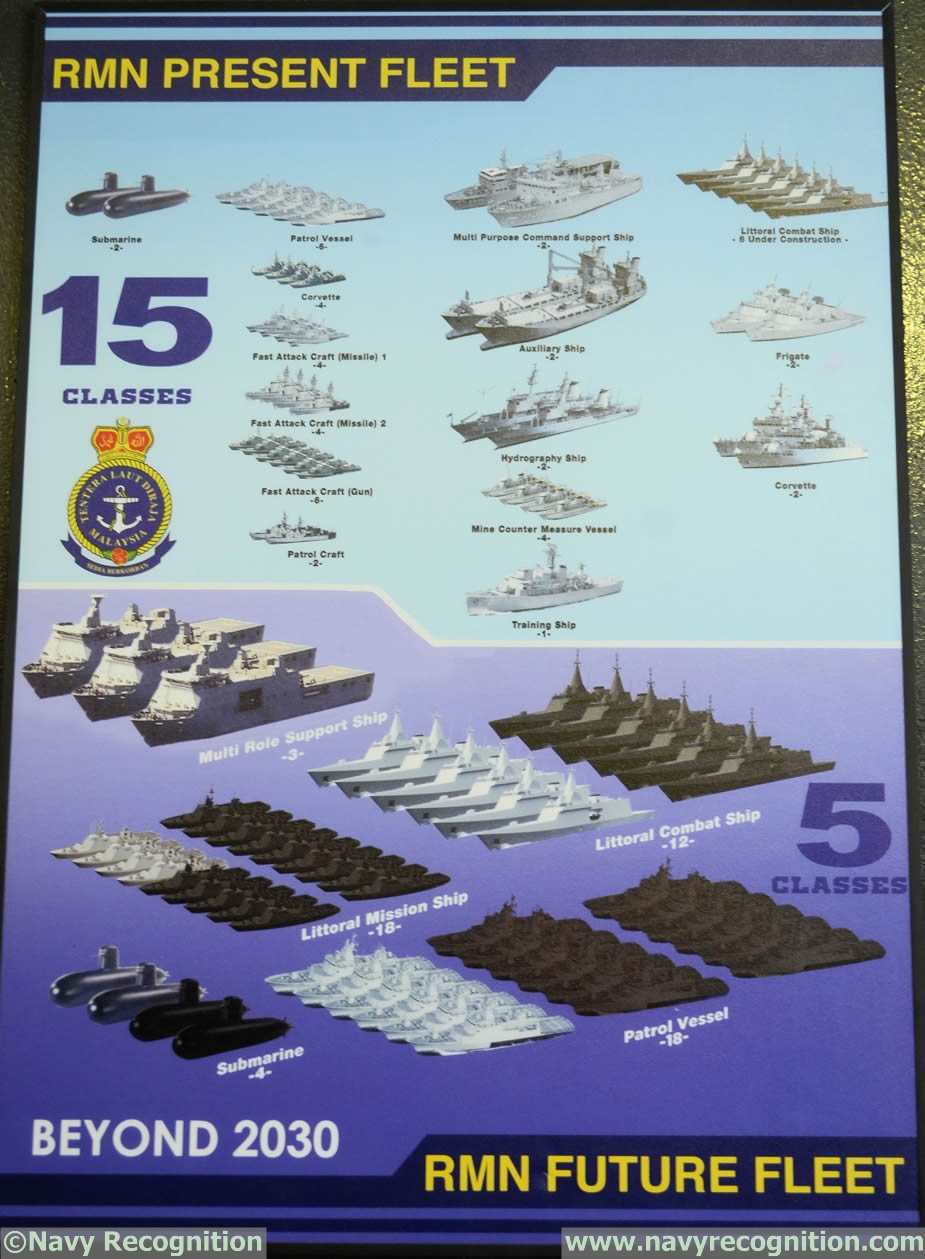Breaking news
Royal Malaysian Navy Looking at Two More Submarines by 2040.
The Royal Malaysian Navy (RMN or TLDM for Tentera Laut Diraja Malaysia) plans to procure another submarine in the 14th Malaysia Plan (2031 – 2035) and one more in the 15th Malaysia Plan (2036 – 2040) as part of its "15 to 5" Transformation Plan. The announcement was made recently by Admiral Tan Sri Ahmad Kamarulzaman, the Chief of the RMN, during a change of command at the RMN’s Submarine Command Headquarters in Kota Kinabalu (the capital of Malaysia’s Sabah state in the northern part of the island of Borneo).

The Royal Malaysian Navy Public Relation Cell shared the following translated statement about the Submarine Force Commander Handover Ceremony:
1. KOTA KINABALU, 26 Feb 18 – The handover ceremony of Submarine Force Commander between Captain Abdullah Sani bin Ismail RMN and Rear Admiral Zulhelmy bin Ithnain was held at the Submarine Force Command Auditorium and was witnessed by the Chief of Navy, Admiral Tan Sri Ahmad Kamarulzaman bin Hj Ahmad Badaruddin.
2. As the new Submarine Force Commander, Rear Admiral Zulhelmy bin Ithnain will shoulder the responsibility of ensuring the readiness of the country’s strategic assets in protecting the nation’s maritime borders. Having the submarines in the RMN’s fleet has increased its capabilities in line with the country’s maritime defence strategic requirements. The government’s investment in procuring the submarines is generally seen as beneficial in upholding maritime security as well as contributing to the nation’s economy, particularly with regards to the maritime claims in the South China Sea.
3. Admiral Tan Sri Ahmad Kamarulzaman said that through the RMN Transformation Plan 15to5, the RMN plans to procure another submarine in the 14th Malaysia Plan (2031 – 2035) and one more in the 15th Malaysia Plan (2036 – 2040). The RMN fleet modernisation’s long-term plan also included procurement of other surface vessels to strengthen its capabilities in modern warfare.
4. During the same event, nine trainees were awarded with the RMN Submarine insignias after successfully passing their basic training course at the Submarine Training Centre. The training centre is a complete training facility for submariners with systematic syllabus and local teaching staff and has produced Malaysian submariners on par with those trained in more developed countries. The facility has also reduced drastically the cost to train submariners by 75 per cent when compared to having them being sent overseas.
5. In addition, the Government also assists in developing the defence industry through the construction of submarine refit facility as well as developing submarine maintenance capabilities. The refit facility was built in partnership between local company Boustead Naval Shipyard and DCNS, the French Scorpene submarine builder. The partnership has resulted in technology and expertise transfers to Malaysian companies and vendors who conduct the repair, scheduled maintenance and submarine refit fully in Kota Kinabalu.
6. At the press conference after the event, Admiral Tan Sri Ahmad Kamarulzaman said he is confident that all the long-term planning currently being done would be able to boost the RMN’s capabilities as well as give returns or dividends to the country. The RMN as the main maritime enforcement agency shoulders the responsibility of ensuring the safety of Malaysian waters, including in eastern Sabah.
Our video interview with Admiral Kamarul, Chief of Navy, about the 15 to 5 plan (recorded during LIMA 2017)
Because of fiscal challenges and the geopolitics situation in the South East Asia region, Admiral Kamarulzaman is rolling out a new transformation and modernization plan called "15 to 5". There are currently 15 classes of ships in the RMN, coming from 7 nations with an average age of 30 years. This represents a large costs in terms of maintenance and operations. As a solution the "15 to 5" plan calls for:
1 - Phasing out of the older vessels in the fleet. This would lead to optimized resources.
2 - Improving procurement processes (reduced and optimized procurement requirements, reduced ill practices) would lead to additional savings for the RMN.
3 - Use these savings to fund the "15 to 5" plan, while focusing on local shipyards and defence industry.
The five classes that would form the Royal Malaysian Navy would be:
» New Generation Patrol Vessel (Kedah-class)
» Littoral Combat Ship (Gowind-class)
» Littoral Mission Ship (able to do 80% of the LCS class missions at 20% of the cost)
» Multirole Supply Ship
» Submarines (Scorpene-class)
The RMN fleet would remain at 55 vessels meaning some additional procurement even among existing classes (such as the Scorpene-class submarines, two of which are already deployed by Malaysia).
 Poster on the RMN stand explaining the 15 to 5 transformation plan (picture taken during LIMA 2017)
Poster on the RMN stand explaining the 15 to 5 transformation plan (picture taken during LIMA 2017)
Q&A with Collin Koh, South East Asia Maritime Security expert
Navy Recognition (NR). Would you say this is as planned, or are those dates "later than originally planned"?
Collin Koh (CK). The RMN long has outstanding plans to procure more than 2 submarines, so this announcement isn’t exactly a new thing. There are some reasons behind this. First, funding shortfalls would mean that such expensive purchases as more submarines would be deferred for a time. In fact, suffice to note, the RMN does have some other outstanding programmes put on the ice for lack of funding, such as the long-proposed Multi-Role Support Ship programme. Second, the reticence earlier to call for purchasing more submarines is also linked to the high-profile controversies surrounding the Scorpene deal that involved Najib, who was then defense minister at that time. The recent announcement seems to indicate that the incumbent government feels confident enough that this old controversy, even if resurfaced to the public, would not gain much traction in the public discourse. Kuala Lumpur has always insisted no wrongdoing or irregularities in the Scorpene deal and would continue to stick to this stance.
But on the financial side, I’m not too sanguine whether the additional pair of submarines may indeed be delivered. The RMN has long contended with the old problem of planning for new acquisition programmes, but failing to receive them within the stipulated timeframe. As I mentioned, there’re other outstanding programmes requiring funding for implementation. I’ll be cautious to see whether the acquisition programme for 2 additional subs will be placed on the priority list.
NR. What do you think of the 15 to 5 plan / is it realistic in your opinion?
CK. On paper, the 15-to-5 Fleet Transformation Programme is sound. It talks about rationalizing scarce resources and streamlining the force structure to make it more manageable from the operational and logistical point of view, and of course, this helps to save money. The RMN has already touted early successes of this programme. But to slash the total classes from 15 to 5 of course, means that the fewer classes of ships have all to be multi-functional. This is possible given the advent of modern naval shipbuilding and technological concepts, that emphasize a lot on modularity and so-called “plug and play” concept. That said, however, I’m skeptical of whether this is realistic. The fewer classes would mean each ship will have much more to do across a much broader, diverse spectrum of missions. If the RMN sticks to the set division of tasks apart from the MMEA then this could be plausibly implemented. But if the RMN has to continue to stand in for much of the offshore responsibilities that the MMEA is supposedly mandated to perform within the vast Malaysian Maritime Zone, then critical mass of assets becomes an issue, and this could be problematic with too few classes of ships.
This leads me to a major practical challenge in this 15-to-5 programme, the fewer classes of ships would mean each class needs to have its requisite planned force size to fulfill those required missions. For example, the Littoral Mission Ship project calls for 18 LMS, 18 New-Generation Patrol Vessels and 12 Littoral Combat Ships. At present, only 6 of the 18 NGPVs are in service. The first LCS were only just launched not long ago. And so were the first quartet of LMS. The transformation programme will only be successful as the build-rate for these new ships can allow. And this is highly dependent on funding commitments. As I mentioned earlier, this is a perennial issue for the RMN, and for its sister services for that matter. Even if no new programmes are included for now, funding for just these planned batches of new ships would be uncertain at best.
NR. 2 more submarines for the RMN, will this bring more capabilities to the RMN and will it "change the balance" in the region?
CK. Firstly, I’m not certain which model the RMN would choose, though common assumption is that it may still purchase the Scorpene since it’s already operating a pair of them so as to leverage on commonalities. But until the final choice of vessel design is decided – and that’s only going to be possible if funding is available to bring this plan off the drawing board – we would only speculate the capabilities for the boats. So qualitative additions aside, the new pair of boats if the plan does go forward would of course enhance the RMN’s capacity. Having 4 instead of 2 boats would allow up to 2 boats to be deployed at any one time, perhaps one close to the peninsular Malaysia and another closer to Sabah and Sarawak. This also would allow more sea time for the RMN submariners, besides relying on shore-based training facilities.
However, I don’t see it as necessarily changing the naval power balance in the region, unless the boats carry certain new capabilities hitherto not seen amongst Southeast Asian navies. Honestly, the RMN submarine programme remains small compared to many of its neighboring counterparts – notably Vietnam with six Kilo class subs, Singapore with a larger fleet of subs, albeit second-hand Swedish ones but awaiting four Type-218SGs from Germany, and Indonesia with its bigger acquisition plans. Perhaps Thailand is closer to match.
Collin Koh is a research fellow at the Maritime Security Programme, S. Rajaratnam School of International Studies in Singapore.



























